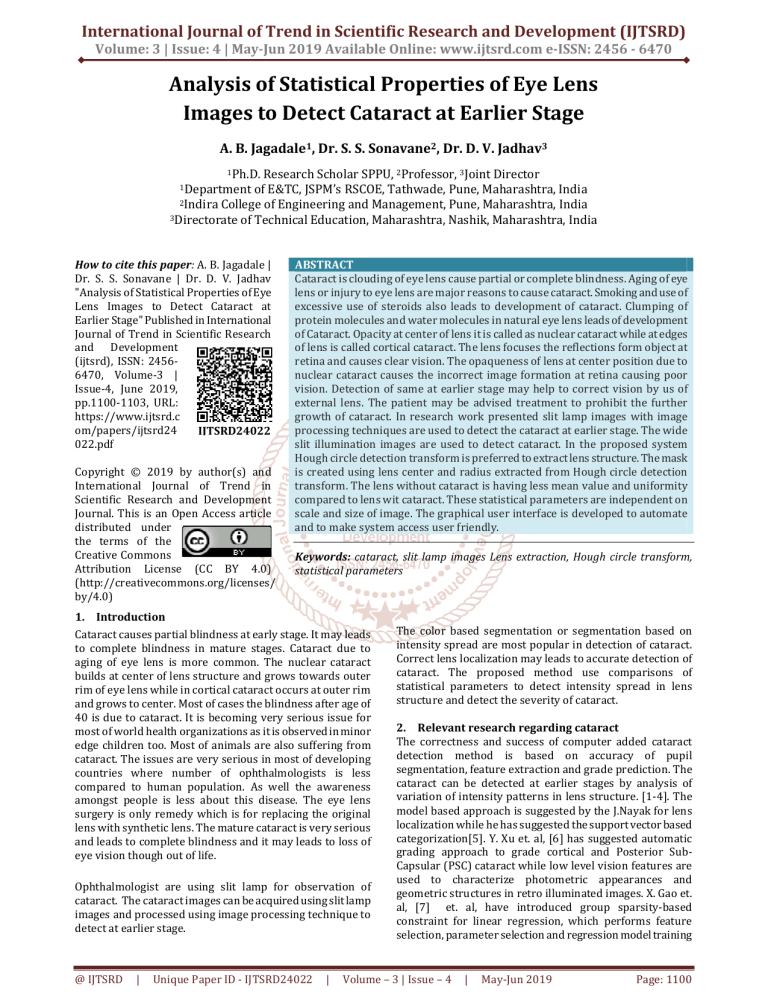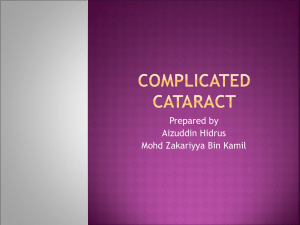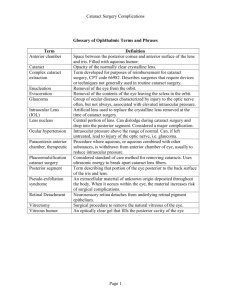
International Journal of Trend in Scientific Research and Development (IJTSRD)
Volume: 3 | Issue: 4 | May-Jun 2019 Available Online: www.ijtsrd.com e-ISSN: 2456 - 6470
Analysis of Statistical Properties of Eye Lens
Images to Detect Cataract at Earlier Stage
A. B. Jagadale1, Dr. S. S. Sonavane2, Dr. D. V. Jadhav3
1Ph.D.
Research Scholar SPPU, 2Professor, 3Joint Director
1Department of E&TC, JSPM’s RSCOE, Tathwade, Pune, Maharashtra, India
2Indira College of Engineering and Management, Pune, Maharashtra, India
3Directorate of Technical Education, Maharashtra, Nashik, Maharashtra, India
How to cite this paper: A. B. Jagadale |
Dr. S. S. Sonavane | Dr. D. V. Jadhav
"Analysis of Statistical Properties of Eye
Lens Images to Detect Cataract at
Earlier Stage" Published in International
Journal of Trend in Scientific Research
and Development
(ijtsrd), ISSN: 24566470, Volume-3 |
Issue-4, June 2019,
pp.1100-1103, URL:
https://www.ijtsrd.c
om/papers/ijtsrd24
IJTSRD24022
022.pdf
Copyright © 2019 by author(s) and
International Journal of Trend in
Scientific Research and Development
Journal. This is an Open Access article
distributed under
the terms of the
Creative Commons
Attribution License (CC BY 4.0)
(http://creativecommons.org/licenses/
by/4.0)
ABSTRACT
Cataract is clouding of eye lens cause partial or complete blindness. Aging of eye
lens or injury to eye lens are major reasons to cause cataract. Smoking and use of
excessive use of steroids also leads to development of cataract. Clumping of
protein molecules and water molecules in natural eye lens leads of development
of Cataract. Opacity at center of lens it is called as nuclear cataract while at edges
of lens is called cortical cataract. The lens focuses the reflections form object at
retina and causes clear vision. The opaqueness of lens at center position due to
nuclear cataract causes the incorrect image formation at retina causing poor
vision. Detection of same at earlier stage may help to correct vision by us of
external lens. The patient may be advised treatment to prohibit the further
growth of cataract. In research work presented slit lamp images with image
processing techniques are used to detect the cataract at earlier stage. The wide
slit illumination images are used to detect cataract. In the proposed system
Hough circle detection transform is preferred to extract lens structure. The mask
is created using lens center and radius extracted from Hough circle detection
transform. The lens without cataract is having less mean value and uniformity
compared to lens wit cataract. These statistical parameters are independent on
scale and size of image. The graphical user interface is developed to automate
and to make system access user friendly.
Keywords: cataract, slit lamp images Lens extraction, Hough circle transform,
statistical parameters
1. Introduction
Cataract causes partial blindness at early stage. It may leads
to complete blindness in mature stages. Cataract due to
aging of eye lens is more common. The nuclear cataract
builds at center of lens structure and grows towards outer
rim of eye lens while in cortical cataract occurs at outer rim
and grows to center. Most of cases the blindness after age of
40 is due to cataract. It is becoming very serious issue for
most of world health organizations as it is observed in minor
edge children too. Most of animals are also suffering from
cataract. The issues are very serious in most of developing
countries where number of ophthalmologists is less
compared to human population. As well the awareness
amongst people is less about this disease. The eye lens
surgery is only remedy which is for replacing the original
lens with synthetic lens. The mature cataract is very serious
and leads to complete blindness and it may leads to loss of
eye vision though out of life.
Ophthalmologist are using slit lamp for observation of
cataract. The cataract images can be acquired using slit lamp
images and processed using image processing technique to
detect at earlier stage.
@ IJTSRD
|
Unique Paper ID - IJTSRD24022
|
The color based segmentation or segmentation based on
intensity spread are most popular in detection of cataract.
Correct lens localization may leads to accurate detection of
cataract. The proposed method use comparisons of
statistical parameters to detect intensity spread in lens
structure and detect the severity of cataract.
2. Relevant research regarding cataract
The correctness and success of computer added cataract
detection method is based on accuracy of pupil
segmentation, feature extraction and grade prediction. The
cataract can be detected at earlier stages by analysis of
variation of intensity patterns in lens structure. [1-4]. The
model based approach is suggested by the J.Nayak for lens
localization while he has suggested the support vector based
categorization[5]. Y. Xu et. al, [6] has suggested automatic
grading approach to grade cortical and Posterior SubCapsular (PSC) cataract while low level vision features are
used to characterize photometric appearances and
geometric structures in retro illuminated images. X. Gao et.
al, [7] et. al, have introduced group sparsity-based
constraint for linear regression, which performs feature
selection, parameter selection and regression model training
Volume – 3 | Issue – 4
|
May-Jun 2019
Page: 1100
International Journal of Trend in Scientific Research and Development (IJTSRD) @ www.ijtsrd.com eISSN: 2456-6470
simultaneously for detection and categorization. R.
Supriyanti et.al, [8,9] used specular reflection appearance,
texture uniformity and average intensity inside the pupil as
cataract detection features. W. Huang et.al, [10] has used
neighboring labeled images in a ranked image list, which is
achieved using a learned ranking function for grading of
nuclear cataract in a slit-lamp image. The ranking function is
learned via direct optimization on a newly proposed
approximation to a ranking evaluation measure.
3. Methodology
The image processing algorithm is developed to detect the
cataract using lens localization technique and extracted
statistical parameters of lens image. The eye images are
acquired using slit lamp mounted camera and processed.
From review it is observed that the success of detection of
any image processing method depends on the correct and
fast localization of lens structure. The lens structure is
circular in shape and its color and texture reflects severity of
cataract. The lens without cataract is black in color and has
mean intensity threshold below 147 for grayscale images
with 8 bit resolution.
The color based segmentations are popular. But in case of
immature and cataract at early stages the detection is hard
using color based segmentation. The circular shape of lens
encourages the researches to use transform based
segmentations. Hough circle detection transform is widely
preferred in iris detection and extraction of iris.
4.1
Let
Input image Pre processing
is the input color eye image acquired using slit
lamp in RGB format with 24 bit resolution per pixel.
…………(1)
Where
and
is gray scale image and
,
are green, red and blue planes.
The input gray scale image is cropped and resized
to
pixels. It is assumed that the cropped
image
iris.
is containing circular lens and no complete
Such that
……………………(2)
4.2
Lens localization using Hough circle detection
transform
It is assumed that the lens radius is within range of 50 to 65
pixels as image is preprocessed and cropped such that lens
radius is within range of 60 to 65. The parameters used in
Hough circle detection transform for lower and higher radius
range are as below.
The Hough transform for circle detection is applied to detect
the pupil in image
to find out pupil center and
radius.
The characteristic equation of circle is given by:
………..(3)
Where (a, b) is center of circle and r is radius of circle
The circle can be described by two equations:
…………………..(4)
…………………..(5)
Figure 1 Flow graph for lens localization and feature
extraction
In proposed method the Hough circle detection transform is
used to extract the lens from eye structure. The transform
transfers the image from the image space to the parametric
space. The accumulator is used to count number of circles
passing though given point. The algorithm uses iterative
procedure to increment the radius of the circle and store the
results. The computational overheads can be reduced by
detecting the circle over predefined radius range.
Hough circle detection transform returns the center and
radius matrix of detected circles. The success of method
depends on the detection of only one pupil circle. For same
the image is cropped and resized to 120 X 120 pixels to
adjust lens radius within range of 60 to 65 pixels range. The
extracted pupil center and radius is used to segment the lens
structure from eye image. The mean intensity value of the
extracted lens without cataract is below 147 and uniformity
is below 0.5. These values are much higher for lens with
cataract.
@ IJTSRD
|
Unique Paper ID - IJTSRD24022
|
Thus the role of hough transform is to search for the triplet
of parameters
which determines the points
. The conversion of image into parametric domain is
as show in figure 2 displayed below.
Let
image
is the gray scale image obtained from color
.
Figure2. Hough transformation from spatial domain to
parametric domain
Volume – 3 | Issue – 4
|
May-Jun 2019
Page: 1101
International Journal of Trend in Scientific Research and Development (IJTSRD) @ www.ijtsrd.com eISSN: 2456-6470
Let
is binary image obtained from input gray scale
image
4.3
Let
Statistical feature extraction:
is the extracted lens structure from the eye
using
image
For given values of
and
let
is the three
dimensional vector representing the circle parameters
where
represents the center of circle and r represents
radius.
Let
and
. The statistical parameters
such as mean, homogeneity and smoothness extracted lens
are calculated.
Mean =
∑
x ( i , j) p ( i , j) ..…..
(8)
i, j
are row and column values if input image
Homogeneit y =
.
then
p(i, j)
∑1+ i- j
...…....(9)
i, j
for all
Smoothness
=1 −
……(6)
1
1 + ∑x(i, j) …...(10)
i, j
such that
The pupil center and radius is given by
The mean homogeneity and smoothness are calculated and
compared with these parameters of lens without cataract.
………….(7)
The lens extracted using Hough circle detection algorithm is
as displayed in figure 3.
Figure3. Lens extracted from slit lamp eye image without
cataractThe image displays the original image, lens
detected, mask for detected lens and extracted lens.
5. Result discussions
The eye images of 400 volunteers with and without cataract
are obtained. The features are calculated and compared. The
results are communicated to ophthalmologist and verified
from them. The result of ten sample images is displayed as
shown in the table below. The proposed systems output and
ophthalmologist is compared. It is observed that the results
obtained from proposed cataract detection system are
correct.
Table No. 5.1 Comparison of system results with
results of ophthalmologists
Image No. Systems Output Doctors opinion
Img001
No
Healthy / N
Img002
Yes
early / Y
Img003
Yes
Nuclear / Y
Img004
Yes
Nuclear /Y
Img005
Yes
mature / Y
Img006
No
Healthy / N
Img007
No
Cortical / Y
Img008
Yes
Nuclear/ Y
Img009
Yes
early/ Y
Img010
Yes
early / Y
Table 2 indicates the confusion matrix generated to calculate
sensitivity, specificity and accuracy obtained.
Table 2: Confusion matrix and results for Hough Circle Detection transform and correlation
Predicted Cataract by proposed algorithm
Yes
No
Actual
Yes
200
40
observation
No
60
100
Total Number of Images
400
Cataract Affected
240
Sensitivity
75
Specificity
62.25
Accuracy
83.33
The accuracy indicated by above method is 83.33% for set of 400 images.
The GUI for detection of cataract has been developed using MATLAB. The images obtained from government hospital
Pandharpur have been processed using Hough circle detection transform and correlation. The result of cataract detection of
eye without cataract is as displayed in figure 3.
@ IJTSRD
|
Unique Paper ID - IJTSRD24022
|
Volume – 3 | Issue – 4
|
May-Jun 2019
Page: 1102
International Journal of Trend in Scientific Research and Development (IJTSRD) @ www.ijtsrd.com eISSN: 2456-6470
[3] The lens opacities classification system III, L. T.
Chylack, J. K. Wolfe, D. M. Singer, M. C. Leske, et al, ,
Archives of Ophthalmology, 111 (1993) 831-836.
[4] Assessment of Cataracts from Photographs in the
Beaver Dam Eye Study, B. E. K. Klein, R. Klein, K. L. P.
Linton, Y. L. Magli, M. W. Neider, Ophthalmology, 97, 11
(1990) 1428-1433.
[5] Automated Classification of Normal, Cataract and Post
Cataract Optical Eye Images using SVM Classifier,
J.Nayak Proceedings of the World Congress on
Engineering and Computer Science 2013, 1 (2013).
[6] Automatic Grading of Nuclear Cataract from Slit-Lamp
Grading Images Using Group Sparsity Regression Y. Xu,
X.Gao, S.Lin, D.Wing, K.Wong, J.Liu, D.Xu, C.Y. Cheng,
C.Y. Cheung, T.Y.Wong , Medical Image Computing and
Computer-Assisted Intervention-MICCAI 2013, Lecture
Notes in Computer Science, 8150 (2013) 468-475.
Figure 3 Detection for eye without cataract
6. Conclusion
Cataract causes lens opacity which leads to partial or
complete blindness. The automated image processing
techniques can be used to develop system to detect the
cataract at earlier stage and help ophthalmologist to
minimize inter grader and intra-grader errors. The Hough
circle detection transform used is accurate to detect the lens
structure gives lens radius and centers used for lens
extraction. The statistical parameters like mean,
homogeneity and smoothness are used to differentiate lens
with cataract and without cataract. The cataract detection
accuracy is 83.33%.
7. References
[1] Prevalence of cataract and pseudophakia/aphakia
among adults in the United States, The Eye Diseases
Prevalence Research Group, Archives of Ophthalmology,
122 (2004) 488-494.
[2] The World Health Report: Life in the 21st Century – A
Vision for All, World Health Organization, Geneva,
1998.
@ IJTSRD
|
Unique Paper ID - IJTSRD24022
|
[7] Automatic Grading of Cortical and PSC Cataracts Using
Retroillumination Lens Images, X. Gao, D.W.K. Wong, T.
T. Ng, C.Y. L. Cheung, C.Y. Cheng, T. Y. Wong, Computer
Vision –ACCV 2012, Lecture Notes in Computer Science,
7725 (2013) 256-267.
[8] Consideration of Iris Characteristic for Improving
Cataract Screening Techniques Based on Digital Image
R. Supriyanti, Y. Ramadhani, 2012 2nd International
Conference on Biomedical Engineering and Technology
IPCBEE, 34 (2012) 126-129.
[9] The Achievement of Various Shapes of Specular
Reflections for Cataract Screening System Based on
Digital Images, R. Supriyanti, Y. Ramadhani, 2011
International Conference on Biomedical Engineering and
Technology IPCBEE, 11 (2011) 75-79.
[10] A Computer Assisted Method for Nuclear Cataract
Grading From Slit-Lamp Images Using Ranking, W.
Huang, K. L .Chan, H. Li, J. H. Lim, J. Liu, And T. Y. Wong,
IEEE Transactions On Medical Imaging, 30, 1(2011) 94107.
Volume – 3 | Issue – 4
|
May-Jun 2019
Page: 1103







